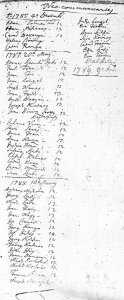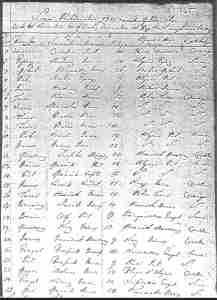General Information.
Roman Catholic confirmations were always performed by the Bishop, and records were usually maintained by the diocese. Occasionally, as in the case shown here, a listing of Roman Catholic confirmands was incorporated into the local church register. Protestant confirmations were more local affairs. In either case, typically, confirmation records were maintained in a separate book and a copy was NOT sent to the Budapest archives with vital records. Therefore, few Hungarian confirmation records were microfilmed for the FHL. Most of the confirmation information accessible on FHL microfilms was mixed in among baptismal records. This most often occurs in Protestant registers in the early years after the reopening of the churches (ie. the 1780s). Even in this period these records are rare. But, when you find them they can occasionally provide valuable information, as was the case with this 1785 Szekszárd confirmation record. The Roman Catholic record from Sür is provided to give an example of what such records look like.




Reformed - 1785 and Roman Catholic - 1845



1785-88 Reformed Confirmations
Szekszárd, Tolna megye.
- This record is in Latin, as evidenced by the title "Neo Communicantes" -- New Communicants, a synonym for Confirmands. Also, the names have Latin ordering (given name followed by family name) and the given name is in Latin (eg. "Joan." for Joannes which is János in Magyar, John in English).
- This is a simple list of the names and ages of the confirmands for each group. Typically, names only are given, so the age in this example is a bonus. In Protestant churches the normal age for confirmation is 12-16. Note that all the confirmands here were 12-14 years old. Sometimes, in addition to the Confirmands name, their father's name is also given, probably to distinguish between families whose name was common in the town.
- FYI - my ancestors Ádam Tolnai (Dec 1785 group) and Sára Seres (May 1787 group) -- who later married -- are both listed here. The ages given here helped me find their baptismal records in the local Roman Catholic church register. [nb. They were born before the Protestant churches of Szekszárd were reopened as a result of Joseph II's Edict of Toleration.]
Sür, Veszprém megye.
- This first page of a Latin-language record is one of several pages listing the 676 persons confirmed that day in the little village of Sür. Many of the confirmands are from neighboring villages and the nearby town of Csetény, which was predominently Protestant and so did not have a Catholic church of its own.
- At the top of the page, the Bishop of Veszprém -- who presided -- is identified as Count Domonkos Zichy. The Zichy family, one of the wealthiest in Hungary, were the principal landowners in the area. The seat of the local branch of the family is a very grand manor house still standing in Várpalota.
- In Roman Catholic confirmation records I've seen, there is often just a simple (and sometimes massive) list of names. As a result, these records are often of very limited value. The record shown here gives more information than usual, but only the age is likely to be useful.
- The columns in this record contain information as follows:
- Sequence number of entry.
- Confirmation (bérmáló neve) name.
- Family name (vezeték neve) and Christening name (keresztel) of the confirmand.
- Age (ideje) of confirmand -- note that many are teenagers as would be expected, but some confirmands are as young as 9 years-old, and several are young adults. Presumably confirmations were performed only rarely in Sür and there was some catching-up to do. The next confirmation recorded in this register was performed in 1876.
- Name of (keresztel) godmother (anya) or godfather (atya).
- Town of Residence (lakhelye).